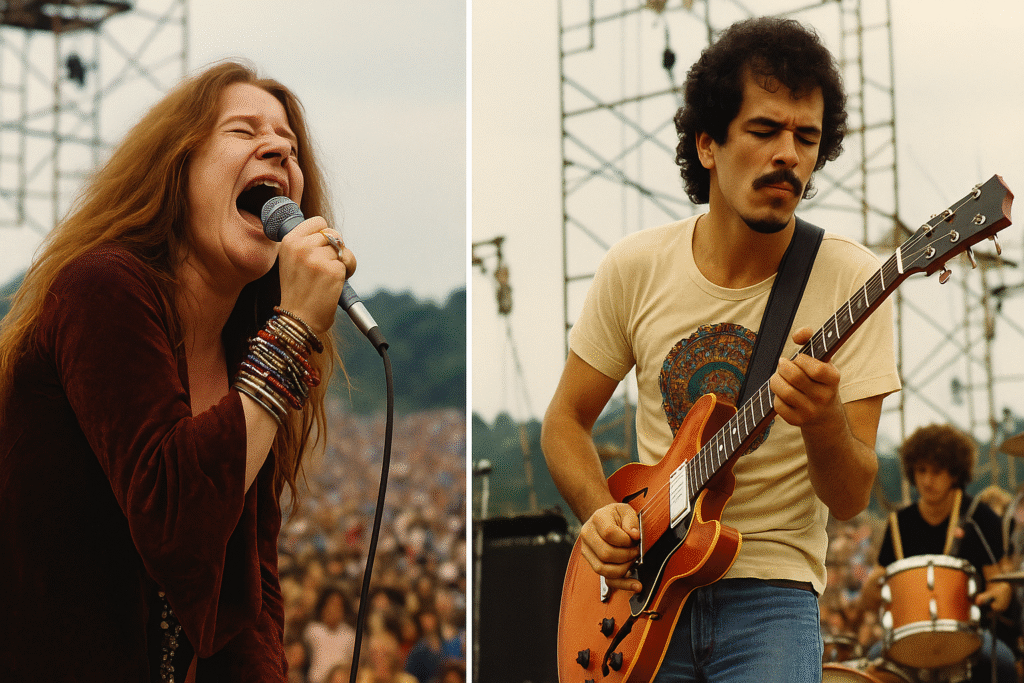
Illustrative image created with artificial intelligence.
Santana: The Latin Fury That Set Woodstock on Fire
On the afternoon of August 16, 1969, the Woodstock crowd had no idea what was coming. Santana — then a virtually unknown band from San Francisco with no album yet released — seemed like just another name filling out the festival’s long roster. But within minutes, Carlos Santana and his crew turned the stage into a volcanic eruption of rhythm.
The blend of blues, rock, and Latin percussion sounded unlike anything the audience had ever heard. Songs like Evil Ways and Jingo drew loud cheers, but it was Soul Sacrifice that blew the roof off. Drummer Michael Shrieve, just 20 years old, unleashed a hypnotic solo that whipped the crowd into the frenzy of a collective ritual.
Santana would later admit he was tripping on LSD during the set, trying to “tame a snake” he hallucinated crawling up his guitar arm. The result was a searing, otherworldly performance captured forever in the Woodstock documentary. In that instant, Santana went from an unknown to one of rock’s brightest rising stars of the ’70s.
The Defining Moment
Soul Sacrifice wasn’t just the band’s breakthrough — it was a turning point for rock itself. For the first time, Latin rhythms were woven seamlessly into the fabric of the genre before a mass audience. Santana walked off the muddy Bethel field straight onto magazine covers, and when their debut album dropped weeks later, it hit with the force of destiny.
Janis Joplin: Vulnerability Turned Into Catharsis
If Santana embodied the new, Janis Joplin arrived at Woodstock as a star already burning. At 26, she had risen to fame with Big Brother and the Holding Company, particularly after the explosive success of Cheap Thrills (1968). She took the stage in the early hours of Sunday, but she wasn’t at her strongest. The toll of alcohol and drugs was becoming hard to hide.
Still, the moment Janis opened her mouth, the field was hers. On Try (Just a Little Bit Harder), her shredded voice tore through the night like both pain and liberation. On Piece of My Heart, she offered her soul in every line, turning fragility into power. But it was Ball and Chain that delivered her most cathartic moment: drenched in sweat, ragged, unsteady — yet utterly surrendered, as if she were burning alive from the inside.
Unlike Santana, Janis drew later criticism for an “imperfect” performance. But Woodstock wasn’t about perfection. It was about truth. Her visceral delivery exposed the rawness of an artist who seemed to live every song like it might be her last.
The Defining Moment
When Janis tore into Ball and Chain, the crowd knew they were witnessing something far beyond music. It was a woman locked in battle — with herself, with her demons, with the world. That brutal honesty is why her memory still haunts rock’s collective soul.
Between Ecstasy and Pain
Santana and Janis Joplin — at opposite ends of the spectrum — embodied the essence of Woodstock: improvisation, intensity, and truth. Santana conquered with unheard-of energy, while Janis revealed the cracks beneath the myth of stardom.
One represented a bright new future; the other, a talent already burning itself to ashes. Together, they gave Woodstock its most emotional afternoon.
Burning Questions
Was Santana already famous when they played Woodstock?
No. They were virtually unknown and walked away as a global revelation.
Why is Michael Shrieve remembered?
His solo on Soul Sacrifice is considered one of Woodstock’s greatest moments — jaw-dropping maturity from a 20-year-old drummer.
Did Janis Joplin disappoint at Woodstock?
Some critics thought so, but the crowd saw raw truth and catharsis. It was more about emotion than precision.
Why was Ball and Chain so important?
Because Janis stripped herself bare. No masks — just total surrender in the face of her own turmoil.
— Lena Blaze, Rock Vaults
